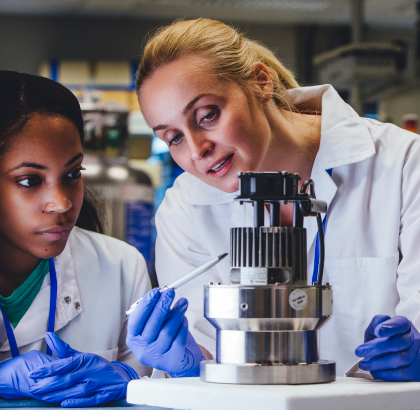Our story begins in 2013, when a major global pharmaceutical firm launched a technology transfer project from one of its US factories to a new factory being constructed in Europe.
For years the US factory had been the sole producer of the company’s successful drug to combat a persistent blood disease that, at best was a lifelong nuisance and, at worst was potentially fatal. With the patient population growing, and with the drug’s success spurring increasing demand in the global market, the firm realized it was time to expand.
The company wanted to identify exactly what was being done at the US site, then train a contingent of several hundred of its European employees so that, upon their return to Europe and completion of the new factory, they could begin operation and production in an immediately successful way.
To get started, the Training Manager at the US factory approached Clarity Consultants with a request for a consultant who would serve as both Project Manager and Training Manager for the mission. Clarity found the perfect match for the project, a consultant who had extensive experience in both roles, along with fluency not only in English but also in the particular language of the EU workers.
The Issues
Once the consultant began the assignment, there were two developments that portended to enlarge the project’s scope:

Since the company anticipated that it might also want to expand capacity beyond just a second factory to other international sites, it decided that the EU factory would be constructed to produce the new drug rather than the one being produced at the US factory.
Second, the US factory operated year-round in three shifts: day, night, and overnight. Production workers were hired into a specific shift, and were trained only to the tasks for that shift. They could not be simply moved to other shifts as needed.
For the EU factory, the company wanted all of its employees to be trained to every task of the entire production process for the new drug, and not just for the tasks of a single shift. The firm wanted to be able to place an employee into any shift at a moment’s notice.
The shift-based training process at the US location was therefore unusable for the new project. The consultant needed to come up with an entirely new training methodology that trained the EU employees in every step of the entire production process for the drug — something that had never been attempted before.
Further, the EU employees had to be trained so well, beyond their own mastery of each task, that they could return to their country and successfully train others in the entire process. The company wanted subsequent EU workers to be trained by this first generation of US-trained EU employees so that, with few exceptions, no further trips to the US were necessary.
Note that to gain regulatory approval, not only the end product — the manufactured drug — but also the entire process had to be approved by the regulatory agencies.
The Answers
The consultant gathered the relevant subject matter experts and extracted their knowledge of the entire production process, identifying for the first time every single step required to produce the drug — more than 400 in all — including the exact sequence of steps, the time required for each, and which documents to follow for each.
With this research in hand he developed an entirely new training methodology and verified it with the experts. He and his team then trained some 250 of the firm’s European employees in the complete, end-to-end manufacturing process for the new drug.
The project lasted three years; it was a massive undertaking.
The US Training Manager wrote: “You made a huge difference to the program and we couldn’t have done it without you.”
In early 2016, the new drug was approved in rapid succession in Canada, the European Union, and (by the FDA) the US.
Two primary metrics of success highlighted this project:
Formerly it took two to two-and-a-half years to train an employee at the US factory not only to the point of performing the process successfully but also teaching it to others successfully. And that was for a single shift’s tasks only. The consultant estimated that, with his new training plan, he was able to reduce this time to between 8 and 9 months — training the employee in the entire production process, not just a single shift. Training time was thus reduced by about two-thirds or more — the employee could be productive that much faster — and production skills were doubled or tripled.
- The consultant estimated that, also because the EU workers were trained to the entire manufacturing process and not just a single shift, the EU factory would be able to run with an FTE reduction of at least 15 percent compared to the US factory.
The most lasting memory during this project for the consultant was Patient Day, when the client company invited the employees and consultants working on the project to meet with the blood disease patients, and hear their stories.
He was deeply moved by the patients’ stories, and was able to experience the human side of healthcare.
He saw how much people cared about these patients, and how much everyone in the company contributed to benefit and better the patients’ lives. In fact, he said he had had no idea to what extreme effort and detail the company and its employees went in order to make these miracles happen and ultimately end up with their product.
And he was further affected by the patients’ enormous connection with and level of gratitude to the company.
When asked if he would be ready to do such a project again, the consultant said yes — in a heartbeat.

 Formerly it took two to two-and-a-half years to train an employee at the US factory not only to the point of performing the process successfully but also teaching it to others successfully. And that was for a single shift’s tasks only. The consultant estimated that, with his new training plan, he was able to reduce this time to between 8 and 9 months — training the employee in the entire production process, not just a single shift. Training time was thus reduced by about two-thirds or more — the employee could be productive that much faster — and production skills were doubled or tripled.
Formerly it took two to two-and-a-half years to train an employee at the US factory not only to the point of performing the process successfully but also teaching it to others successfully. And that was for a single shift’s tasks only. The consultant estimated that, with his new training plan, he was able to reduce this time to between 8 and 9 months — training the employee in the entire production process, not just a single shift. Training time was thus reduced by about two-thirds or more — the employee could be productive that much faster — and production skills were doubled or tripled.